ISLAMABAD: The International Monetary Fund (IMF) on Tuesday maintained Pakistan’s economic growth forecast for the current fiscal year at 3.5 percent but suggested that global de-inflation will slow and continue to exert pressure on the people amid higher and prolonged interest rates.
The IMF in April this year maintained its growth forecast for Pakistan at 3.5 percent, but strengthened it about a week earlier after its staff agreed to a 37-month, $7 billion bailout package with Pakistani authorities based on detailed discussions and exchange of financial and economic data, including the 2024-25 budget.
The government has set its economic growth target for this fiscal year at 3.6%.
In an update to its World Economic Outlook 2024, the IMF noted that while the overall risks to the global economic outlook are balanced as reported in April, some near-term risks are prominent affecting emerging market economies and oil-importing countries such as Pakistan.
These include the risk of rising inflation arising from a lack of progress in deflation in the services sector, as well as price pressures arising from rising trade and geopolitical tensions.
Warns inflation pressures will continue
IMF staff projections are based on upward revisions to commodity prices, including a 5% increase in non-fuel prices in 2024. The fund now sees energy prices falling about 4.6% in 2024, lower than its April forecast and “reflecting higher oil prices due to significant production cuts by OPEC+ (the Organization of the Petroleum Exporting Countries, which includes Russia and other non-OPEC oil exporters) and reduced (but still existing) price pressures from the Middle East conflict.”
The IMF said major central banks’ monetary policy rates are expected to fall as soon as the second half of 2024, but the pace of normalization will vary, reflecting diverse inflationary developments. “Risks of higher inflation raise the prospect of interest rates remaining elevated for a longer period, thereby increasing external, fiscal and financial risks,” it said, adding that a prolonged strengthening of the dollar resulting from interest rate differentials could disrupt capital flows, impeding planned monetary policy easing and adversely affecting growth.
“Unless fiscal improvements offset rising real interest rates amid lower potential growth, persistently high interest rates could push up borrowing costs further, with implications for financial stability,” the IMF said.
Pakistan is one of the top economies struggling with high borrowing needs and high interest rates amid a slow growth cycle. Nearly all government revenue is being consumed in debt repayments.
Policies to promote multilateralism and speed up the implementation of macro-structural reforms could boost supply growth, productivity and growth, with positive spillovers across the world, the report said.
Advice for central banks
The IMF therefore called for making economies future-proof by working persistently to restore price stability and address the legacies of the recent crisis, including by replacing lost buffers and providing a lasting boost to growth. In the near term, this will require careful adjustment and sequencing of the policy mix.
The IMF recommended that central banks refrain from easing too quickly and be open to further tightening if necessary. With fiscal policy space shrinking, the IMF suggested that they should seriously adhere to their commitments to achieving fiscal consolidation targets with the help of sound fiscal frameworks and resource mobilization.
In emerging market and developing countries, recent policy divergences have highlighted the need to manage the risks of currency and capital flow volatility. Given that economic fundamentals remain the primary driver of dollar strength, the appropriate response is to use monetary policy to keep inflation closer to target while allowing exchange rates to adjust.
Foreign exchange reserves should be used prudently and held to counter potentially worse outflows in the future. To the extent possible, macroprudential policies should mitigate vulnerabilities from large exposures to foreign currency debt. Short-term challenges aside, policymakers must act now to reverse declining medium-term growth prospects.
The migration of young and educated people can impose a burden on sending countries, but these costs can be mitigated through policies that leverage migrant networks, maximize the benefits of remittances, and expand domestic labor market opportunities.
Published in Dawn on July 17, 2024

